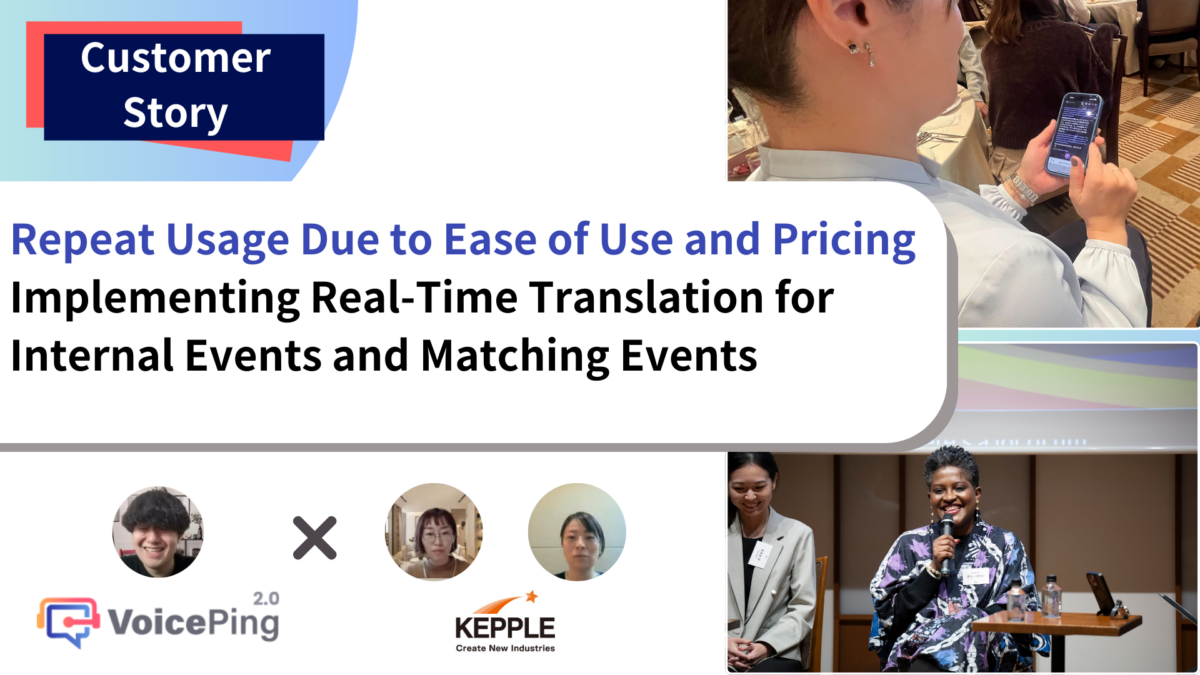Global Collaboration Transcending Language Barriers: Kepple Group's VoicePing Implementation Case Study
Kepple Group Co., Ltd. is a company that supports both startups and investors, contributing to the development of the startup industry. As they strengthened cooperation with the international startup ecosystem, communication methods to overcome language barriers became essential.
This time, we spoke with Yumi Tomita from the Public Relations department and Saki Akao from the Global Strategy Section, who utilized VoicePing at two different events: an African startup matchmaking tour and a company-wide event.
A Startup Support Company with a Global Vision
First, could you introduce yourselves and your roles at the company?
Tomita:I’m Tomita from Kepple Group Co., Ltd. At the company, I’m in charge of public relations and managing the startup media we operate. In my role as PR, I’m also involved in internal communications, specifically managing company-wide meetings and supporting events run by other departments.
Akao:I’m Akao from Kepple Co., Ltd. I belong to the Global Strategy Section, where I work on bridging Japanese business companies with overseas startups and venture capital firms.
Specifically, I provide reports on overseas market startup information to business companies and organize seminars inviting overseas VCs.
So your company as a whole focuses on startup support?
Tomita:That’s right. We support both startups and investors, and we uphold the mission of contributing to the development of the startup industry from both directions.
Challenges at Two Global Events

You used VoicePing at two events this time. Could you tell us about each event?
Akao: The event I was in charge of was a matchmaking tour where 10 African startups came to Japan to make initial connections with Japanese companies. On the first day of the three-day schedule, we used VoicePing when everyone gathered for the opening session. From when it was decided that the African startups would be coming, I spent about two to three months researching their focus areas and the situation in Japan, and conducted recruitment activities for matching with Japanese companies.
Tomita: I was in charge of a Kepple Group company-wide internal event held on November 4th. Kepple Group is a group company consisting of a holding company and related subsidiaries, and an outside director who usually resides in Kenya came to Japan. Since all employees are currently Japanese, we basically hold parties in Japanese, but we wanted that outside director to also understand the party content, so we utilized VoicePing.
Background of VoicePing Implementation: Ease of Use and Cost Performance
There are many translation tools available, but could you tell us why you chose VoicePing among them?

Tomita: Akao’s team had previously used it at an event where overseas guests spoke, and we had a track record with it. The ease of use at that time and the fact that users could simply scan a QR code to easily view the translation were very good points.
Previous use case: https://voice-ping.com/blog/jp-customer-success-kepple/
You could say it has an excellent UI, or ease of use, and a reasonable cost, so although we were introduced to other translation services, we decided to continue using it again this time.
Communication Transcending Language Barriers Realized with QR Codes
How did using VoicePing at these events actually solve problems?
Akao:uring presentations by people who came from Africa and by people from the International Trade Center that was hosting, it was very good that Japanese participants could understand the translated content smoothly just by scanning the QR code, without downloading anything in particular. The fact that everything could be used at that seminar with a shared understanding, smoothly without any steps, was really good.
It was very convenient that you could transcend language barriers just by placing one “please scan here” on the slide, and everyone could become one without feeling any obstacles.
What languages were primarily used at the African event?
Akao: Since all the African participants were fluent in English, we basically translated from English to Japanese, and when there were Q&A sessions, we also translated from Japanese to English. Among the Japanese business company participants, there were both those who could speak English and those who couldn’t, so regardless of that, I think VoicePing enabled communication.
Thank you. How was it at the company-wide event?
Tomita: At the company-wide event, there was one foreign English speaker as a guest, and all participating employees were Japanese. When the guest made presentations, we translated from English to Japanese, and when the guest was listening, we translated from Japanese to English.
Being alone among all Japanese people, I think they might have felt anxious, but we later received comments saying they could understand the content of the event and their words got through, which was very good.
Accommodating Diverse Accents: Proven Performance at Global Events
So you primarily used Japanese and English translation. How was the translation accuracy?
Tomita:We received feedback from employees saying, “I thought translation tools would still translate content in a rough way, but surprisingly, it translated with high accuracy in a timely manner. The technology has really advanced.” I think there were no particular problems.
How were the reactions from participants and the atmosphere during the events?
Akao: At the internal event, I was sitting next to the guest outside director, Orie-san, the whole time. Normally, with different languages, you might feel excluded if you don’t understand, but I could confirm that she was constantly looking at her phone understanding CEO Asaki’s talk and other members’ talks, so I myself didn’t feel a barrier between us, and there was an atmosphere of understanding even without explaining.
Tomita:I was checking VoicePing at the pitch event. The speakers also introduced their companies in an easy-to-understand way, so I think people could view the translated content without any particular problems. I think many participants could speak English, but there were also those who needed support, so I think it was very useful.
Were there any issues with audio pickup and other preparations?
Tomita:At the company-wide meeting, for the first part where the outside director spoke, we connected the audio line directly to the PC to pick up the sound. This was because we wanted to ensure the content could be clearly heard and translated. In the latter part, we had the PC and microphone pick up the venue’s sound for translation, but I don’t think there were any issues with accuracy in either case. I think at the African event too, the venue’s microphone system was connected to the audio and PC.
Were there any points you’d like improved, or anything you thought “this could be a bit better”?
Tomita:At the internal event, we tried to project the translated content on a screen. It was good that we could change the font size and color, but the background was black-based, so if it had been white, the text would have been easier to read. If there are any updates in the future, I think it would be nice if we could display black text on a white background, especially when projecting it at a venue that’s somewhat dim.
Akao: Regarding operability, I was able to use it while reading the detailed instructions you provided in Notion, which was good. Also, there might already be a separate function for this, but other tools have a mechanism where content is sent as a summary document at the end, and I thought that would be convenient when using it for meetings.
QR Code Feature Resolves Venue Constraints
Could you tell us about future prospects and goals for your company and teams? Whether or not they involve VoicePing is fine.
Akao: Moving forward, as part of our global startup business support, we’re also operating a Climate Tech Consortium for decarbonization, and we’d like to continue incorporating overseas information for our members and holding seminars.
Tomita:The Global Strategy Section team is increasingly promoting overseas collaboration. We now have foreign outside directors and outside auditors, and services we’ve provided domestically up until now are also heading in the direction of global expansion going forward.
I think opportunities to communicate with foreign people will increase in various situations, so while utilizing tools like these, I want to put even more effort into broadening our global perspective and having each employee and member expand such perspectives.
Post-Event Review Efficiency Through Meeting Log Features
We introduced VoicePing implementation case studies at two different global events at Kepple Group Co., Ltd.: an African startup matchmaking tour and a company-wide event.
With the ease of simply scanning a QR code, no app download required, all participants could participate in the events with a sense of unity without feeling language barriers, which was a major achievement.
What was particularly impressive was the point that “regardless of whether people could or couldn’t speak English, everyone could communicate.” This allowed Japanese participants to understand English presentations, and guests from overseas could grasp the content of events conducted in Japanese.
For companies like Kepple Group that are accelerating global expansion, we will continue making improvements so that VoicePing can become not just a translation tool, but important infrastructure for realizing international collaboration.
Future Vision: Creating Innovation Beyond Language Barriers
VoicePing removes language barriers with fast and accurate real-time translation, providing an environment where participants of different nationalities and cultures can interact seamlessly.
📱 Just scan a QR code!
No app download required. Translation content can be easily checked on smartphones.
Benefits of implementing VoicePing:
🌍 Multinational participants understand content in their native language
We provide an environment where participants can deeply understand without feeling language barriers at any session.
⚡ Reduce burden with easy operation and high-precision translation
Intuitive operation and quick translation significantly reduce the workload for organizers.
💡 Improve participant satisfaction and event evaluation
By utilizing translation support, you can enhance the overall quality of events and obtain positive feedback from participants.
If you want to evolve your next event into a venue for international knowledge sharing, please utilize VoicePing!
For more details, please apply for an individual consultation.
Experience VoicePing’s effectiveness with a free trial. Sign up here


